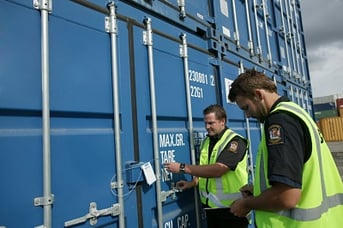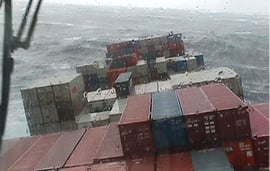Summer is nearing its end, which means vacation season is coming to a close. Did you travel anywhere this summer? Perhaps to the beach or a favorite lake or state park? Did you travel by car? If so, how did you navigate your way from point A to point B?
If you’re like many Americans, you relied on GPS technology. It’s easy to forget that just a few short years ago, most of us would print off directions before driving to a new destination. And only a few years before that we relied on actual maps, of all things. Today, the thought of pulling out a map or road atlas seems laughable.
So if GPS is such a critical tool for your family road trip, why aren’t you also using it for your high-value industrial shipments? At Deufol, we recently released an advanced GPS technology system for industrial customers. It not only tracks location, but also gives you a wide range of information about your container while it’s in transit.
Not using GPS to its fullest capabilities? Not sure whether you need it? Below are three signs that GPS could be a valuable and beneficial technology for your packaging and shipping processes. If any of these sound familiar, it’s time for you to consider implementing GPS into your industrial project.
1. You need detailed location information.
The most obvious benefit of GPS technology is that it can give you information about your package, crate, or container’s location while it is in transit. Of course, you likely know the route that your container is taking, so you may not think you need a GPS to confirm that information.
However, GPS can provide much more detailed information that could save you time and money. For example, assume your container is going to a large and complicated industrial project site. The worksite has a large number of workers operating in many different areas. The site receives a heavy volume of containers and packages from hundreds of vendors on a daily basis.
GPS technology helps you identify mishandling so you can take quick action.
You have a package with a high-value part shipping to your worksite. You’re on a tight schedule so you need your team to receive and unpack the crate as soon as it arrives, so the part can immediately be installed and the project can move forward on schedule.
With GPS technology, you and your team can simply log into your internal software and view exactly where and when the package will be delivered. If the package is already onsite, your team can use the GPS to quickly locate it.
You don’t have the time or the budget flexibility for your team to wander around the job site looking for a particular package. You need them to locate packages quickly, identify the parts and materials needed, and push forward with the next task in the project. GPS technology helps your team stay efficient and on schedule.
2. You’re worried about tampering or activity with the package.
It’s possible that your package could move through several different receiving docks and facilities before it makes it to its final destination. It may go through shipping hubs, packaging centers, and even customs facilities.
At any of those stops, it’s possible that the package could be opened and even repackaged in a way that doesn’t meet your standards. For example, a customs agent may decide to inspect your package by opening it and removing some of the dunnage and other contents. Of course, the agent isn’t informed about your packaging standards, so they don’t repack your container in the way you would hope.
 The same could inadvertently happen at a shipping facility or at a vendor hub or any other facility along the transit route. Obviously, you would like to know if your package is opened so your team can look into the situation and take corrective action.
The same could inadvertently happen at a shipping facility or at a vendor hub or any other facility along the transit route. Obviously, you would like to know if your package is opened so your team can look into the situation and take corrective action.
GPS technology gives you that information. You can use GPS to see changes in air pressure inside the package or container. If the package is opened and the air pressure changes, you get a notification. You can then communicate with representatives at the package’s location or you can deploy your team members to check on the container’s status.
Your shipment is too valuable and important to leave to chance. Accidents and mistakes happen. But they don’t have to go uncorrected. GPS technology helps you identify mishandling so you can take quick action.
3. Your part or material is sensitive to the elements.
In many industrial projects, parts and materials have to meet an extremely high quality standard. If a gear or bearing or other part is damaged or corroded by even a tiny unit of measurement, it may not be fit for your project.
Any number of elements — from barometric pressure to moisture to sunlight and more — could affect the quality and structural integrity of your materials. Even the slightest amount of tilt and shock could damage your part.
Our industrial GPS systems can check for moisture levels, air pressure, light exposure, temperature, vibration, and much more.
Of course, the real problem is that you may not find out about this damage until the part reaches your work site. Your team unpacks the container only to find that the part doesn’t meet standards. By that point, you’ve already lost valuable time in your schedule. Getting a replacement will delay your project and drain money from your budget.
What if you could see this potential damage as it is happening? What if you could see that moisture had penetrated the package, or that the container had shifted in a volatile way that fell outside the allowable range?
 If you could see these threats in real time, you could have your team check the container’s contents while it’s in transit. If there was damage, you could get a replacement part or material sent out immediately, eliminating any delay in the project schedule.
If you could see these threats in real time, you could have your team check the container’s contents while it’s in transit. If there was damage, you could get a replacement part or material sent out immediately, eliminating any delay in the project schedule.
Again, GPS technology gives you this capability. Our industrial GPS systems are about much more than just location. They can check for moisture levels, air pressure, light exposure, temperature, vibration, and much more.
We work with you to identify potential threats. We then design and package a container to minimize those threats. And finally, we use GPS technology so we can monitor the container’s stability and safety while in route.
Not using GPS technology for your industrial shipments? You may be needlessly exposing your project to high levels of risk. Let’s take back control of your shipping and supply process. Contact us today. Our industrial packaging engineers are happy to discuss your needs and goals with you, and recommend how GPS can help you overcome your challenges.








Let Us Know What You Thought about this Post.
Put your Comment Below.